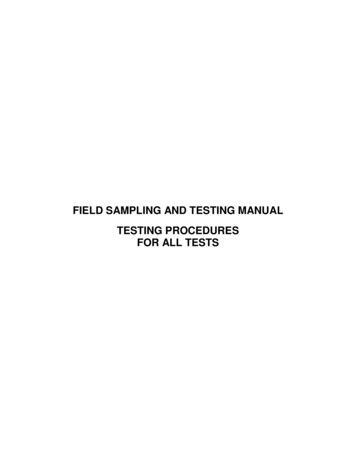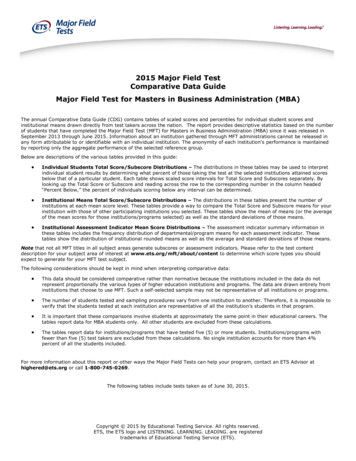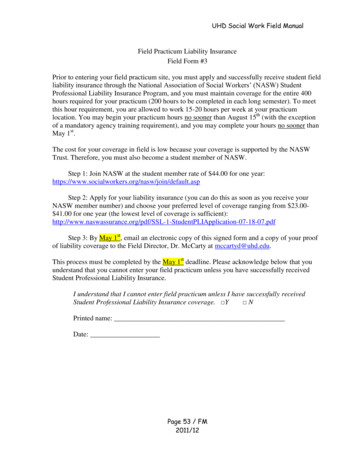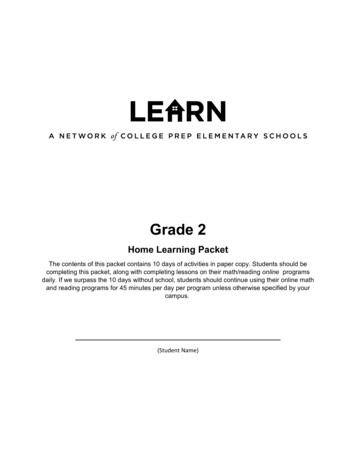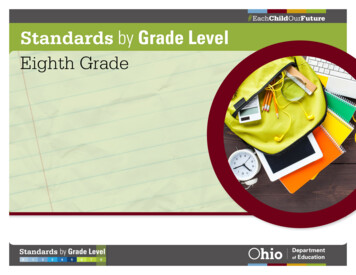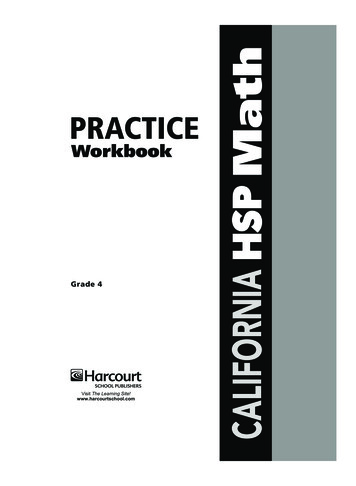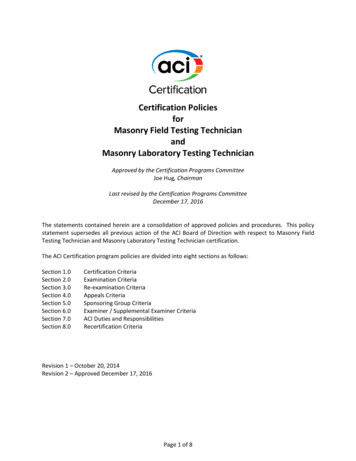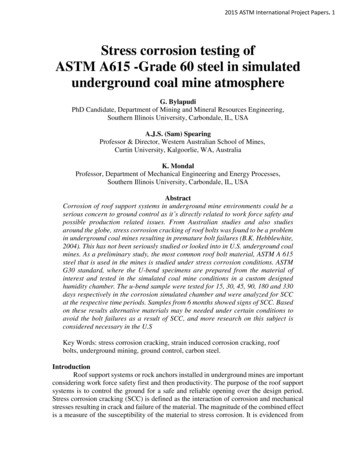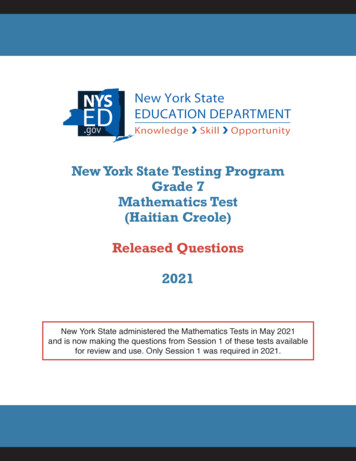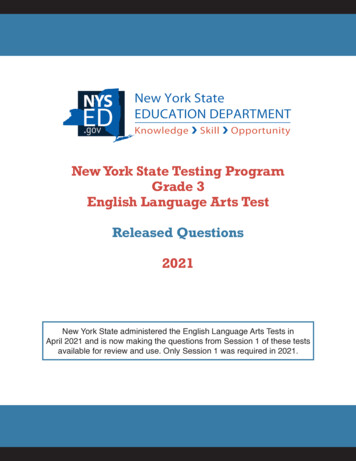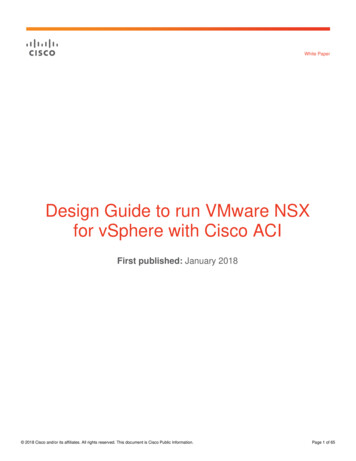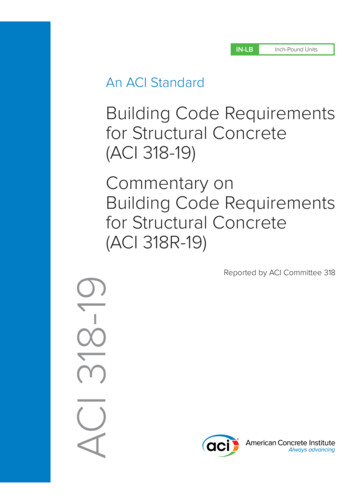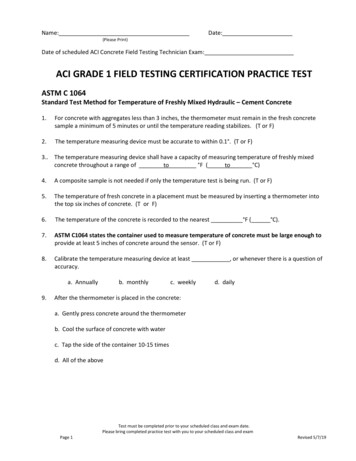
Transcription
Name:(Please Print)Date:Date of scheduled ACI Concrete Field Testing Technician Exam:ACI GRADE 1 FIELD TESTING CERTIFICATION PRACTICE TESTASTM C 1064Standard Test Method for Temperature of Freshly Mixed Hydraulic – Cement Concrete1.For concrete with aggregates less than 3 inches, the thermometer must remain in the fresh concretesample a minimum of 5 minutes or until the temperature reading stabilizes. (T or F)2.The temperature measuring device must be accurate to within 0.1 . (T or F)3. The temperature measuring device shall have a capacity of measuring temperature of freshly mixedconcrete throughout a range of F ( C)toto4.A composite sample is not needed if only the temperature test is being run. (T or F)5.The temperature of fresh concrete in a placement must be measured by inserting a thermometer intothe top six inches of concrete. (T or F)6.The temperature of the concrete is recorded to the nearest F ( C).7.ASTM C1064 states the container used to measure temperature of concrete must be large enough toprovide at least 5 inches of concrete around the sensor. (T or F)8.Calibrate the temperature measuring device at least , or whenever there is a question ofaccuracy.a. Annually9.b. monthlyc. weeklyd. dailyAfter the thermometer is placed in the concrete:a. Gently press concrete around the thermometerb. Cool the surface of concrete with waterc. Tap the side of the container 10-15 timesd. All of the abovePage 1Test must be completed prior to your scheduled class and exam date.Please bring completed practice test with you to your scheduled class and examRevised 5/7/19
Name:(Please Print)Date:Date of scheduled ACI Concrete Field Testing Technician Exam:10. According to ASTM C1064, what is one reason to take the temperature of concrete?a. Verify conformanceb. Verify ambient air temperaturec. Verify slumpd. None of the above.11. It is allowable to remove the temperature measuring devices from the freshly mixed concrete to read thetemperature if you cannot see the reading. (T or F)Page 2Test must be completed prior to your scheduled class and exam date.Please bring completed practice test with you to your scheduled class and examRevised 5/7/19
Name:(Please Print)Date:Date of scheduled ACI Concrete Field Testing Technician Exam:ASTM C172Standard Test Method for Sampling Freshly Mixed Concrete1.The maximum allowable time between obtaining the first and last portions of the compositesample may not exceed 5 minutes. (T or F).2.Start molding specimens for strength tests within 30 minutes after fabricating the composite sample.(T or F)3.The composite concrete sample must be protected from sun, wind, contamination and rapidevaporation. (T or F)4.If the concrete contains aggregates larger than those that are appropriate for a size of mold orequipment used, the sample should be wet-sieved before making the test. (T or F)5.The composite sample should not be remixed before beginning any tests. (T or F)6.Sampling should normally be performed, as the concrete is discharged from the mixer. (T or F)7.ASTM Method C172 includes sampling from stationary mixers, paving mixers, truck mixers, agitators,and non-agitating equipment. (T or F)8.After sampling is completed, start the tests for slump and air content within:a. 2 ½ minutesb. 10 minutesc. 15 minutesd. None of the above9. In any case, do not obtain samples until:a. All the water and admixtures have been added to the concreteb. 200 revolutions of the drum have been obtainedc. ½ of the water has been addedd. None of the above10. No samples shall be taken before or after of the batch has been discharged.a. 10% or after 90%Page 3b. 20% or after 90%c. 20% or after 80%d. None of the aboveTest must be completed prior to your scheduled class and exam date.Please bring completed practice test with you to your scheduled class and examRevised 5/7/19
Name:(Please Print)Date:Date of scheduled ACI Concrete Field Testing Technician Exam:11. When strength tests are to be made, the minimum size of the composite sample shall be:a. ¼ cubic footb. 1 cubic footc. Any convenient sized. 1 Wheelbarrow12. Sample the concrete from the chute of a truck mixer by:a. Raising chute to stop the flow and scoop concrete from there into the slump cone andcylinder moldsb. Passing a receptacle completely through the discharge steam or by completely diverting thedischarge into the sample containerc. Holding a shovel in the flow and direct half into a bucketd. None of the above13. Fresh concrete to be tested at the job site should be sampled from:a. The beginning of mixer dischargeb. The last concrete dischargedc. Two or more regularly spaced intervals during discharge of the middle portion of the batchd. All of the above14. The elapsed time between obtaining the first and final portions of the composite sample,according to ASTM C172, shall not exceed:a. 10 minutesPage 4b. 20 minutesc. 30 minutesd. None of the aboveTest must be completed prior to your scheduled class and exam date.Please bring completed practice test with you to your scheduled class and examRevised 5/7/19
Name:(Please Print)Date:Date of scheduled ACI Concrete Field Testing Technician Exam:ASTM C143Standard Test Method for Slump of Hydraulic-Cement Concrete1.The sides of the slump cone should be tapped with the mallet to consolidate the concrete in the mold.(T or F)2.For the slump test, when Rodding the second layer and the top layer, the tamping rod should justpenetrate into the underlying layer. (T or F)3.According to ASTM C143, it is permissible to use a mold, which clamps to a non-absorbent base.(T or F)4.When filling the final layer of the slump cone, never heap the concrete above the top of the mold.(T or F)5.The filling of the slump cone should be done in three layers of equal height. (T or F)6.The slump test may be done on any flat surface. (T or F)7.When filling the slump cone, each layer should be rodded 25 times. (T or F)8.The slump cone is filled in three layers of equal volume. (T or F)9Concrete should be removed from around the base before the cone is lifted. (T or F)10. The slump cone should be raised carefully, vertically upward, in a steady motion in Secondsa. 2 to 6b. 4 to 8c. 3 to 7d. 5 to 911. The elapsed time between the start of filling the slump cone and the removal of the cone must be nomore than:a. 1 minuteb. 2 1/2 minutesc. 5 minutesd. 15 minutes12. The slump should be measured to the nearesta. Tenth of an inchb. Quarter of an inchc. Half of an inchd. 1 inchPage 5Test must be completed prior to your scheduled class and exam date.Please bring completed practice test with you to your scheduled class and examRevised 5/7/19
Name:(Please Print)Date:Date of scheduled ACI Concrete Field Testing Technician Exam:13. In order to determine slump, you should measure the vertical distance from:a. Top of the mold to the highest point of the slumped concreteb. Top of the concrete to the base of the concretec. Top of the mold to the displaced original center of the top surfaced. None of the above14. The dimensions of the slump cone are:a. Top diameter 6 inches, bottom diameter 12 inches, height 12 inchesb. Top diameter 4 inches, bottom diameter 8 inches, height 16 inchesc. Top diameter 4 inches, bottom diameter 8 inches, height 12 inchesd. None of the above15. In the slump test, if a decided falling away or shearing off the concrete from one side or portion ofthe mass occurs upon raising the slump cone, one should:a. Reject the load for lack of uniformityb. Accept the load but warn the plantc. Disregard the test and make a new test when the next load arrivesd. Disregard the test and make a new test on another portion of the sample16. The slump cone should be struck-off with:a. A float or trowelb. A straight edgec. The tamping rodd. Any of the above17. The slump cone must be placed:a. Only on the flat base provided by the mold’s manufacturerb. On a flat, clean, dry, wooden surfacec. On a flat moist, non-absorbent, rigid surfaced. On flat, dampened, compacted soilPage 6Test must be completed prior to your scheduled class and exam date.Please bring completed practice test with you to your scheduled class and examRevised 5/7/19
Name:(Please Print)Date:Date of scheduled ACI Concrete Field Testing Technician Exam:ASTM C138Standard Test Method for Density (Unit Weight) Yield of Concrete1.When rodding the second and third layers, the rod should penetrate the preceding layer by about1 inch. (T or F)2.The normal ½ cubic foot bucket may not be used to determine Density (unit weight) of lightweightconcrete. (T or F)3.Concrete slump of less than 1 inch should be consolidated using a vibrator. (T or F)4.ASTM C138 states, “the minimum capacity of the bucket depends on the maximum slumprequirement.” (T or F)5.According to ASTM C138, after rodding each layer, tap the sides of the container, with the rod exactly25 times. (T or F)6.The outside of the density bucket should be cleaned before weighing. (T or F)7.Concrete with a slump less than 1 inch should be rodded 25 times per layer. (T or F)8.According to C138, concretes with slumps of 1-3 inches may be compacted with the vibrator orthe rod. (T or F)9.The unit weight bucket must be calibrated at least once a month. (T or F)10. According to ASTM C138, when rodding the bottom layer, the rod shall not forcibly strike the bottomof the measure. (T or F)11. The strike-off plate must be:a. At least ¼ inch thick if metalb. Flatc. At least ½ inch thick if glass or acrylicd. All of the abovePage 7Test must be completed prior to your scheduled class and exam date.Please bring completed practice test with you to your scheduled class and examRevised 5/7/19
Name:Date:(Please Print)Date of scheduled ACI Concrete Field Testing Technician Exam:12. Given the following: wt of bucket 16.2 lbs, volume of bucket 0.498 cf, wt of bucket and concrete 88.5lbs.a. 140.7 lb/ft³b. 145.2 lb/ft³c. 177.7 lb/ft³d. None of the above13. What is the optimum amount of the concrete that should be protruding above the top of the moldafter the third layer has been tapped by the mallet?a. Noneb. About a 1/8th inchc. About 1 inchd. About 2 ½ inches14. After strike-off, the next operation is:a. Tap the sides of the container smartly 10-15 times with the appropriate malletb. Rod the top layer 25 times with the tamping rodc. Clean the excess concrete from the exterior of the measured. Determine the net weight of concrete in the measure15. Strike-off density (unit weight) bucket by:a. Using a trowel in a sawing motionb. Using a straightedge in a sawing motionc. Using a flat plate in a sawing motiond. None of the above16. If the density (unit weight) of concrete is 146 lb/ft³ and the total batch weight is 35,468 lb.,what is the yield?a. 9.7 yd³b. 7.0 yd³c. 9.0 yd³d. 243 yd³17. The tamping, rod used for the unit weight test:a. A round, straight steel rodb. Has a 5/8 inch diameter with the tamping end roundedc. Is approximately 24 inches in lengthd. All of the abovePage 8Test must be completed prior to your scheduled class and exam date.Please bring completed practice test with you to your scheduled class and examRevised 5/7/19
Name:(Please Print)Date:Date of scheduled ACI Concrete Field Testing Technician Exam:18. For a design batch of 9.0 cubic yards, the total weight of all materials batched was 36,400 lb.,and the actual yield was 9.5 cubic yards. What was the relative yield?a. 1.06b. 0.95c. 4044 ft³d. 3832 lbs.19. Determine the air content. Total material batched 37,500 lbs design yield 9.0 yd³ theoretical unitwt. 150.0 lbs/ft³ actual unit wt. 140.0 lbs/ft³ actual yield 9.6 yd³a. 7.1%b. 6.7%c. 8.7%d. Not enough informationAdditional Sample Problems are attached to the end of this test.Page 9Test must be completed prior to your scheduled class and exam date.Please bring completed practice test with you to your scheduled class and examRevised 5/7/19
Name:(Please Print)Date:Date of scheduled ACI Concrete Field Testing Technician Exam:ASTM C231Standard Test Method for Air Content of Freshly Mixed Concrete (Pressure Method)1.The pressure method should be used for determining the air content of concrete containinglightweight aggregates. (T or F)2.The aggregate correction factor should only be used when concrete containing lightweightaggregate is being tested. (T or F)3.After consolidation, if the measure contains a great excess of material, remove a quantity ofrepresentative concrete then strike off the surface. (T or F)4.ASTM C231 covers procedures for both Type A and Type B meters. (T or F)5.During filling with water, once water emerges through the opposite petcock, the Type Bpressure meter should be jarred to expel all air bubbles through the petcock. (T or F)6.Using the Type B meter, the gauge should read to the nearest 0.1%. (T or F)7.Wet sieving is needed when the sample of fresh concrete contains aggregates larger than2 inches. (T or F)8. After the Type B pressure meter is filled with water and all the air has been expelled through thepetcock:a. Pump up the pressure chamber until the gauge reads zerob. Pump up the pressure chamber until the gauge reads the coarse aggregate correction factorc. Close the bleeder valve and pump up the pressure chamber and adjust the gauge to the initialpressure lined. Close the bleeder valve and pump the meter to the maximum pressurePage 10Test must be completed prior to your scheduled class and exam date.Please bring completed practice test with you to your scheduled class and examRevised 5/7/19
Name:(Please Print)Date:Date of scheduled ACI Concrete Field Testing Technician Exam:9. Given that the reading on the pressure gauge is 5.3 percent, unit weight 143.7 lbs/cf, slump 6.5 inches,and aggregate correction factor is 0.2 percent, what is the air content?a. 5.1 %b. 5.3%c. 5.5%d. None of the above10. To determine the air content use the Type B meter:a. Read the gauge directly. This is the air content.b. Read the gauge and add th
ASTM C 1064 . Standard Test Method for Temperature of Freshly Mixed Hydraulic – Cement Concrete . 1. For concrete with aggregates less than 3 inches, the thermometer must remain in the fresh concrete sample a minimum of 5 minutes or until the temperature reading stabilizes. (T or F) 2. The temperature measuring device must be accurate to within 0.1 . (T or F)
